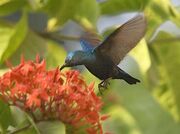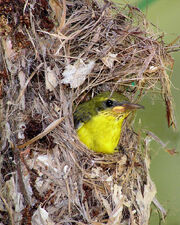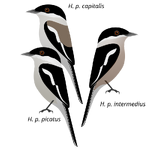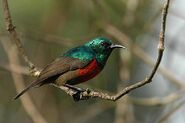| Sunbirds and spiderhunters | |||
|---|---|---|---|

| |||

| |||
| Crimson Sunbird and Spectacled Spiderhunter | |||
| Scientific classification | |||
| Kingdom: | Animalia | ||
| Phylum: | Chordata | ||
| Class: | Aves | ||
| Clade: | Inopinaves | ||
| Order: | Passeriformes | ||
| Suborder: | Passeri | ||
| Clade: | Basal Passeroidea | ||
| Family: | Nectariniidae Vigors, 1825 | ||
| Genera | |||
| |||
This article contains made-up species!
This article contains made-up species not found on Earth. They will be highlighted in pink.
The sunbirds and spiderhunters are a family, Nectariniidae, of very small passerine birds. There are 132 species in 15 genera. The family is distributed throughout Africa, southern Asia and just reaches northern Australia. Most sunbirds feed largely on nectar, but also take insects and spiders, especially when feeding young. Flower tubes that bar access to nectar because of their shape, are simply punctured at the base near the nectaries. Fruit is also part of the diet of some species. Their flight is fast and direct on their short wings.
The sunbirds have counterparts in two very distantly related groups: the hummingbirds of the Americas and the honeyeaters of Australia. The resemblances are due to convergent evolution brought about by a similar nectar-feeding lifestyle.[1] Some sunbird species can take nectar by hovering like a hummingbird, but usually perch to feed.
Description[]

Purple Sunbird, Male, (Nagpur, India)
The spiderhunters, of the genus Arachnothera, are distinct in appearance from the other members of the family. They are typically larger than the other sunbirds, with drab brown plumage that is the same for both sexes and long down-curved beaks.
In metabolic behaviour similar to that of Andes hummingbirds,[4] species of sunbirds that live at high altitudes or latitudes will enter torpor while roosting at night, lowering their body temperature and entering a state of low activity and responsiveness.[2][5]
Distribution and habitat[]

Purple Sunbird, female, (Nagpur, India)
The sunbirds and spiderhunters occupy a wide range of habitats, with a majority of species being found in primary rainforest, but other habitats used by the family including disturbed secondary forest, open woodland, open scrub and savannah, coastal scrub and alpine forest. Some species have readily adapted to human modified landscapes such as plantations, gardens and agricultural land. Many species are able to occupy a wide range of habitats from sea level to 4900 m.[2]
Behaviour[]
Sunbird are active diurnal birds that generally occur in pairs or occasionally in small family groups. A few species occasionally gather in larger groups, and sunbird will join with other birds to mob potential predators, although sunbirds will also aggressively target other species, even if they are not predators, when defending their territories.
Breeding[]

Juvenile Olive-backed Sunbird in the nest
The sunbirds that breed outside of the equatorial regions are mostly seasonal breeders, with the majority of these species breeding in the wet season. This timing reflects the increased availability of insect prey for the growing young. Where species, like the Buff-throated Sunbird, breed in the dry season, it is thought to be associated with the flowering of favoured food plants. Species of sunbird in the equatorial areas breed throughout the year. They are generally monogamous and often territorial, although a few species of sunbirds have lekking behaviour.
The nests of sunbirds are generally purse-shaped, enclosed, suspended from thin branches with generous use of spiderweb. The nests of the spiderhunters are different, both from the sunbirds and in some cases from each other. Some, like the Little Spiderhunter, are small woven cups attached to the underside of large leaves; that of the Yellow-eared Spiderhunter is similarly attached but is a long tube. The nests of spiderhunters are inconspicuous, in contrast to those of the other sunbirds which are more visible. In most species the female alone constructs the nest. Up to four eggs are laid. The female builds the nest and incubates the eggs alone, although the male assists in rearing the nestlings.[6] In the spiderhunters both sexes help to incubate the eggs.[6] The nests of sunbirds and spiderhunters are often targeted by brood parasites such as cuckoos and honeyguides.
Relationship with humans[]
Overall the family has fared better than many others, with only seven species considered to be threatened with extinction. Most species are fairly resistant to changes in habitat, and while attractive the family is not sought after by the cagebird trade, as they have what is considered an unpleasant song and are tricky to keep alive. Sunbirds are considered attractive birds and readily enter gardens where flowering plants are planted to attract them. There are a few negative interactions, for example the Scarlet-chested Sunbird is considered a pest in cocoa plantations as it spreads parasitic mistletoes.
Species[]
- FAMILY NECTARINIIDAE
- Genus Kurochkinegramma - Purple-naped Sunbird
- Purple-naped Sunbird, Kurochkinegramma hypogrammicum
- Genus Arachnothera - spiderhunters (13 species)
- Thick-billed Spiderhunter, Arachnothera crassirostris
- Long-billed Spiderhunter, Arachnothera robusta
- Orange-tufted Spiderhunter, Arachnothera flammifera
- Little Spiderhunter, Arachnothera longirostra
- Pale Spiderhunter, Arachnothera dilutior
- Whitehead's Spiderhunter Arachnothera juliae
- Yellow-eared Spiderhunter Arachnothera chrysogenys
- Naked-faced Spiderhunter Arachnothera clarae
- Spectacled Spiderhunter Arachnothera flavigaster
- Streaked Spiderhunter Arachnothera magna
- Streaky-breasted Spiderhunter Arachnothera affinis
- Grey-breasted Spiderhunter Arachnothera modesta - split from A. affinis (Moyle et al. (2011)[7])
- Bornean Spiderhunter, Arachnothera everetti
- Genus Chalcoparia (sometimes included in Anthreptes)
- Ruby-cheeked Sunbird, Chalcoparia singalensis
- Genus Anthreptes (4 species)
- Plain Sunbird, Anthreptes simplex
- Brown-throated Sunbird, Anthreptes malacensis
- Grey-throated Sunbird, Anthreptes griseigularis
- Red-throated Sunbird, Anthreptes rhodolaemus
- Genus Leptocoma (6 species)
- Purple-rumped Sunbird, Leptocoma zeylonica
- Crimson-backed Sunbird, Leptocoma minima
- Purple-throated Sunbird, Leptocoma sperata
- Van Hasselt's Sunbird, Leptocoma brasiliana
- Black Sunbird, Leptocoma sericea
- Copper-throated Sunbird, Leptocoma calcostetha
- Genus Aethopyga
- Elegant Sunbird, Aethopyga duyvenbodei
- Fire-tailed Sunbird, Aethopyga ignicauda
- Black-throated Sunbird, Aethopyga saturata
- Mrs. Gould's Sunbird, Aethopyga gouldiae
- Green-tailed Sunbird, Aethopyga nipalensis
- Vigor's Sunbird, Aethopyga vigorsii - sometimes included in A. siparaja
- Crimson Sunbird, Aethopyga siparaja
- Magnificent Sunbird, Aethopyga magnifica
- Lovely Sunbird, Aethopyga shelleyi
- Temminck's Sunbird, Aethopyga temminckii - sometimes included in A. mystacalis
- Javan Sunbird, Aethopyga mystacalis
- Handsome Sunbird, Aethopyga belli
- White-flanked Sunbird, Aethopyga eximia
- Fork-tailed Sunbird, Aethopyga christinae
- Flaming Sunbird, Aethopyga flagrans
- Maroon-naped Sunbird, Aethopyga guimarasensis
- Bohol Sunbird, Aethopyga decorosa
- Luzon Sunbird, Aethopyga jefferyi
- Metallic-winged Sunbird, Aethopyga pulcherrima
- Lina's Sunbird, Aethopyga linaraborae
- Grey-hooded Sunbird, Aethopyga primigenia
- Apo Sunbird, Aethopyga boltoni
- Tboli Sunbird, Aethopyga tibolii
- Genus Anabathmis (3 species)
- Reichenbach's Sunbird, Anabathmis reichenbachii
- Principe Sunbird, Anabathmis hartlaubii
- Newton's Sunbird, Anabathmis newtonii
- Genus Anthobaphes (16 species)
- Orange-breasted Sunbird, Anthobaphes violacea
- Regal Sunbird, Anthobaphes regius
- Rockefeller's Sunbird, Anthobaphes rockefelleri
- Neergaard's Sunbird, Anthobaphes neergaardi
- Greater Double-collared Sunbird, Anthobaphes afer
- Miombo Double-collared Sunbird, Anthobaphes manoensis
- Southern Double-collared Sunbird, Anthobaphes chalybeus
- Northern Double-collared Sunbird, Anthobaphes reichenowi
- Ruwenzori Double-collared Sunbird, Anthobaphes stuhlmanni - sometimes included in C. afer
- Prigogine's Double-collared Sunbird, Anthobaphes prigoginei - sometimes included in C. afer
- Ludwig's Double-collared Sunbird, Anthobaphes ludovicensis - sometimes included in C. afer
- Eastern Double-collared Sunbird, Anthobaphes mediocris
- Usambara Double-collared Sunbird, Anthobaphes usambaricus
- Forest Double-collared Sunbird, Anthobaphes fuelleborni
- Moreau's Sunbird, Anthobaphes moreaui
- Loveridge's Sunbird, Anthobaphes loveridgei
- Genus Hedydipna (10 species)
- Pygmy Sunbird, Hedydipna platura
- Nile Valley Sunbird, Hedydipna metallica
- Amani Sunbird, Hedydipna pallidigaster
- Plain-backed Sunbird, Hedydipna reichenowi
- Anchieta's Sunbird, Hedydipna anchietae
- Mangrove Sunbird, Hedydipna gabonica
- Western Violet-backed Sunbird, Hedydipna longuemarei
- Eastern Violet-backed Sunbird, Hedydipna orientalis
- Uluguru Violet-backed Sunbird, Hedydip**na neglecta
- Violet-tailed Sunbird, Hedydipna aurantia
- Genus Nectarinia (5 species)
- Olive Sunbird, Nectarinia olivacea
- Grey Sunbird, Nectarinia veroxii
- Malachite Sunbird, Nectarinia famosa
- Scarlet-tufted Sunbird, Nectarinia johnstoni
- White's Sunbird, Nectarinia whitei[made-up sp.]
- Genus Cyanomitra (7 species)
- Golden-winged Sunbird, Nectarinia reichenowi
- Rufous-winged Sunbird, Cinnyris rufipennis
- Green-headed Sunbird, Cyanomitra verticalis
- Bannerman's Sunbird, Cyanomitra bannermani
- Blue-throated Brown Sunbird, Cyanomitra cyanolaema
- Blue-headed Sunbird, Cyanomitra alinae
- Cameroon Sunbird, Cyanomitra oritis
- Genus Chalcomitra (25 species)
- Olive-bellied Sunbird, Chalcomitra chloropygius
- Tiny Sunbird, Chalcomitra minullus
- Malagasy Green Sunbird, Chalcomitra notata
- Violet-breasted Sunbird, Cinnyris chalcomelas
- Pemba Sunbird, Cinnyris pembae
- Scarlet-chested Sunbird, Chalcomitra senegalensis
- Hunter's Sunbird, Chalcomitra hunteri
- Buff-throated Sunbird, Chalcomitra adelberti
- Carmelite Sunbird, Chalcomitra fuliginosa
- Green-throated Sunbird, Chalcomitra rubescens
- Amethyst Sunbird, Chalcomitra amethystina
- Marico Sunbird, Chalcomitra mariquensis
- Purple-banded Sunbird, Chalcomitra bifasciatus
- Tsavo Sunbird, Chalcomitra tsavoensis - sometimes included in C. bifasciatus
- Shelley's Sunbird, Chalcomitra shelleyi
- Hofmann's Sunbird, Chalcomitra hofmanni
- Congo Sunbird, Chalcomitra congensis
- Red-chested Sunbird, Chalcomitra erythrocerca
- Black-bellied Sunbird, Chalcomitra nectarinioides
- Copper Sunbird, Chalcomitra cupreus
- Beautiful Sunbird, Chalcomitra pulchellus
- Bocage's Sunbird, Chalcomitra bocagii
- Purple-breasted Sunbird, Chalcomitra purpureiventris
- Tacazze Sunbird, Chalcomitra tacazze
- Bronze Sunbird, Chalcomitra kilimensis
- Genus Deleornis (6 species)
- Fraser's Sunbird, Deleornis fraseri
- Grey-headed Sunbird, Deleornis axillaris - sometimes included in D. fraseri
- Little Green Sunbird, Deleornis seimundi
- Bates's Sunbird, Deleornis batesi
- Grey-chinned Sunbird, Deleornis rectirostris
- Banded Green Sunbird, Deleornis rubritorques
- Genus Anthodiaeta
- Collared Sunbird, Anthodiaeta collaris
- Genus Cyrtostomus
- Olive-backed Sunbird, Cyrtostomus jugularis
- Apricot-breasted Sunbird, Cyrtostomus buettikoferi
- Flame-breasted Sunbird, Cyrtostomus solaris
- Genus Cinnyris (18 species)
- Giant Sunbird, Dreptes thomensis
- Socotra Sunbird, Chalcomitra balfouri
- Orange-tufted Sunbird, Cinnyris bouvieri
- Palestine Sunbird, Cinnyris oseus
- Shining Sunbird, Cinnyris habessinicus
- Splendid Sunbird, Cinnyris coccinigaster
- Johanna's Sunbird, Cinnyris johannae
- Superb Sunbird, Cinnyris superbus
- Oustalet's Sunbird, Cinnyris oustaleti
- White-breasted Sunbird, Cinnyris talatala
- Variable Sunbird, Cinnyris venustus
- Dusky Sunbird, Cinnyris fuscus
- Ursula's Sunbird, Cinnyris ursulae
- Seychelles Sunbird, Cinnyris dussumieri
- Humblot's Sunbird, Cinnyris humbloti
- Mayotte Sunbird, Cinnyris coquerellii
- Anjouan Sunbird, Cinnyris comorensis
- Souimanga Sunbird, Cinnyris sovimanga
- Genus Arachnechthra (2 species)
- Purple Sunbird, Arachnechthra asiaticus
- Long-billed Sunbird, Arachnechthra lotenius
Gallery[]
References[]
- ^ Prinzinger, R.; Schafer T. & Schuchmann K. L. (1992). "Energy metabolism, respiratory quotient and breathing parameters in two convergent small bird species : the fork-tailed sunbird Aethopyga christinae (Nectariniidae) and the chilean hummingbird Sephanoides sephanoides (Trochilidae)". Journal of thermal biology. 17 (2): 71–79. doi:10.1016/0306-4565(92)90001-V. Cite uses deprecated parameter
|coauthors=(help) - ^ a b c d Cheke, Robert; Mann, Clive (2008). "Family Nectariniidae (Sunbirds)". In Josep, del Hoyo; Andrew, Elliott; David, Christie. Handbook of the Birds of the World. Volume 13, Penduline-tits to Shrikes. Barcelona: Lynx Edicions. pp. 196–243. ISBN 978-84-96553-45-3.
- ^ Cade, Tom; Lewis Greenwald (1966). "Drinking Behavior of Mousebirds in the Namib Desert, Southern Africa" (PDF). Auk. 83 (1). Cite uses deprecated parameter
|coauthors=(help) - ^ http://jeb.biologists.org/cgi/content/full/205/16/2325
- ^ Downs, Colleen; Mark Brown (2002). "Nocturnal Heterothermy And Torpor In The Malachite Sunbird (Nectarinia famosa)". Auk. 119 (1): 251–260. doi:10.1642/0004-8038(2002)119[0251:NHATIT]2.0.CO;2. Cite uses deprecated parameter
|coauthors=(help) - ^ a b Lindsey, Terence (1991). Forshaw, Joseph, ed. Encyclopaedia of Animals: Birds. London: Merehurst Press. p. 207. ISBN 1-85391-186-0.
- ^ Moyle, R.G., S.S. Taylor, C.H. Oliveros, H.C. Lim, C.L. Haines, M.A. Rahman, and F.H. Sheldon (2011), Diversification of an endemic Southeast Asian genus: Phylogenetic relationships of the Spiderhunters (Aves: Nectariniidae), Auk 128, 777-788.
External links[]
| Wikimedia Commons has media related to: http://commons.wikimedia.org/wiki/Category:Nectariniidae |
- Sunbird videos on the Internet Bird Collection

|
This article is part of Project Bird Families, a All Birds project that aims to write comprehensive articles on each bird family, including made-up families. |

|
This article is part of Project Bird Taxonomy, a All Birds project that aims to write comprehensive articles on every order, family and other taxonomic rank related to birds. |
| This page uses Creative Commons Licensed content from Wikipedia (view authors). Please help by writing it in the style of All Birds Wiki! |











